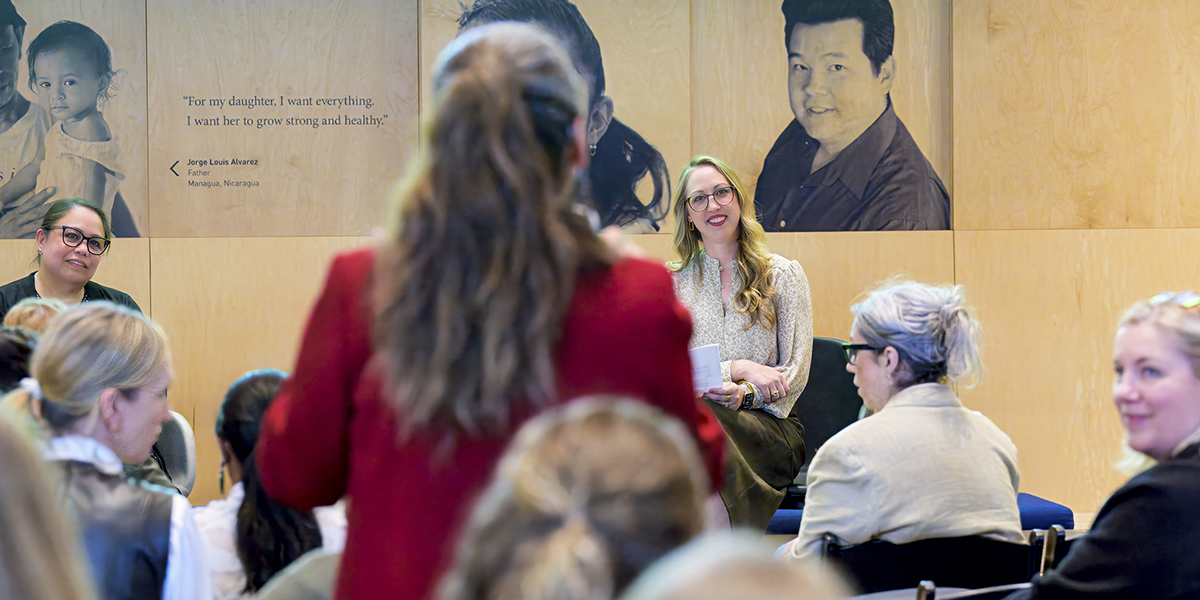Written by Dr. Renee St. Jacques – Photo by Christina @ wocintechchat.com
“Listening is not the absence of talking. It is the foundation for talking.” – Kathleen Macferran
In a culture that seems to emphasize academics over all else, a softer skill has emerged as a popular and transformational concept in shaping success in the workplace: Emotional Intelligence.
Emotional Intelligence (EQ) is the ability to perceive, understand, and manage one’s emotions, and judiciously and empathetically be in relationship with another.
Soft-skill or not, Emotional Intelligence isn’t just a nice-to-have.
People with average IQ but high EQ consistently outperform those with the with the highest IQ. In fact, EQ is the strongest predictor of performance across 33 workplace skills, and is so strongly correlated with earnings, that every EQ point adds $1,300 to one’s annual salary across regions and sectors.
The truth is – our work is only as good as our skills of working with other people. The good news is that Emotional Intelligence can be learned and put to work quickly. Learning to listen well is a skill that people across the EQ spectrum can invest in immediately.
This post explores 7 principles of active listening and how to apply them for stronger workplace relationships:
1. Listen to build trust.
People can’t work well when they don’t feel psychologically safe. Where lack of trust leads people to become defensive and self-preserving, high-quality listening fosters an environment where people feel psychologically safe and more receptive to constructive feedback and promotes attitude complexity, or the ability to see both sides of an argument.
Listening carefully indicates to other that they and their perspectives matter. The positive experience of being heard compounds, encouraging people to engage in ever-greater degrees of collaboration and deepening of workplace relationships.
Try this: In your next workplace conversation, make your primary goal to ensure that your conversation partner feels seen and heard.
2. Listen for understanding. It’s not about you.
A key component to building trust is to commit to “listening to understand” – that is, being attentive to what the person is actually saying, beyond than the literal words.
As Peter Drucker, renown author and management consultant said, “The most important thing in communication is hearing what isn’t said.” This requires listening without pretense, refraining from judgement and issuing advice.
Try this: In your next workplace conversation, notice any instinct to judge or solve the other person’s problem or turn the conversation to yourself. Instead, focus on what they’re saying – or not saying – and what they actually need from you at the moment.
3. Listen to make people feel heard – not to prepare a response.
Are you a good listener? Most people believe they have above-average listening skills, yet the majority listen with only 25% efficiency while much of our attention is diverted to formulating a response.
Native Americans used a Talking Stick to practice the art of listening. The person who holds the stick controls the conversation until they feel understood. Only then do they pass the stick to the next person to offer their response or counter point. In this way, the listener is motivated to invest entirely in understanding since their opportunity to respond depends on the other’s sense of being understood.
Try this: Hold your attention to what the other is saying – rather than formulating a response – by reflecting back what they are saying. For example, “I hear you saying that you feel ____ and you need ____ from me. Is that right?”
4. Listen to validate.
Recognize the power of validation. Often misunderstood as concession or agreement, validation simply acknowledges and accepts that what the other person is experiencing is real and true.
Opportunities for validation often follow a mismatch between impact and intention: an action made in good faith has an unexpected and detrimental impact on another. Validation requires accepting that the impact is real, refraining from justification or dismissing the impact based on original intent.
Try this: Next time you experience a misunderstanding with a colleague, resist responding with an explanation. First reflect back (see point #3) and accept their experience as truth.
5. Listen to identify the root issue.
Initial reactions are often a symptom of a deeper wound. When faced with a problem in the workplace, it’s important to recognize that there may be layers of intermediate symptoms between the issue at hand and the root cause. Many times, the root cause is internal, and requires drilling into the subconscious to identify the common denominator to problems, relentlessly asking “why?”, challenging beliefs, and deepening consciousness.
Try this: Familiarize with the Root Cause Analysis (RCA), a powerful active listening tool for tracing a problem to its origin. Practice the listening loop, asking the right questions, and listening again before offering a “fix.”
6. Listen with your eyes.
We’ve all had that encounter where the words are right, but we walk away feeling uneasy. Most likely the speaker’s words and body language were in conflict. According to HR and management consultant, Susan M. Heathfield, if a person’s words say one thing, and their non-verbal communication says another, listening to the nonverbal is the right way to go.
Learning to read non-verbal communication broadens your listening toolkit, offering clues to someone’s mind through the subconscious.
Try this: At your next virtual meeting, instead of looking at your computer – even to take notes – keep your eyes on the speaker. Investigate discord by asking thoughtful questions such as those in the RCA process and let what you find inform how to proceed.
7. Listen for action and opportunity.
Active listening is just that: active. Listening in the workplace involves hearing what is being said, what isn’t being said, and what is left out entirely. When we leave a meeting without a clear path of action, we leave opportunities on the table and undermine our impact.
Similarly, active listening positions you to better identify lack of direction and help solve for ambiguity through thoughtful questions in a way that drives collaboration rather than defensiveness and competition.
Try this: Reflect back what is being said and ask questions that deepen understanding for yourself and the group. Notice the level of engagement of those around you as well as the speaker(s) themselves.
Putting these 7 principles of active listening to work has the potential to improve the way you relate to others in your work and personal life. At minimum, you will gain better understanding of those around you, deepening your emotional intelligence and ability to collaborate more productively. Beyond that, you can inspire change in those around you, setting off a chain reaction of constructive relationship-building and optimizing the capacity to create impact, achieve clarity, influence change, and optimize opportunity.
 Licensed psychologist Dr. Renee St Jacques is a unique hybrid of human behavior expert and corporate professional, equally compassionate and people-oriented while biased towards action and results-oriented. Her deep experience with technology marketing and product management give her the senior-level perspective to understand the business issues that her clients face daily, while her extensive doctoral training in psychology offers her the intuition and expertise to help support her clients’ workplace relational and emotional intelligence needs.
Licensed psychologist Dr. Renee St Jacques is a unique hybrid of human behavior expert and corporate professional, equally compassionate and people-oriented while biased towards action and results-oriented. Her deep experience with technology marketing and product management give her the senior-level perspective to understand the business issues that her clients face daily, while her extensive doctoral training in psychology offers her the intuition and expertise to help support her clients’ workplace relational and emotional intelligence needs.








0 Comments